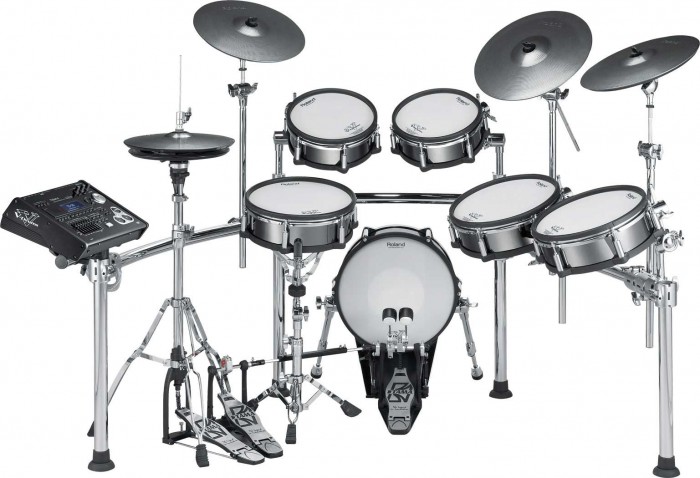Electronic Drum Kits vs Acoustic Drum Kits
What Should I Be Hitting?
by Ben Shannon, Sono School Of Music
I’ve had many students ask me if they should purchase an electronic or acoustic drum kit. The answer to this question isn’t a simple one. I believe that your decision should be based on certain factors. Due to the complexity and confusion in the selection process I have decided to summarize the pro’s and con’s of each kit type to help you make an informed decision about which kit type will best suits your needs.
Electronic Drum Kits
The electronic drum kit has become increasingly popular in the last 30 years due to rapid developments in technology and increasing affordability and availability. Console computer games such as Rock Band or Guitar Hero have also implemented the use of electronic or dummy kits to great effect and have spearheaded the popularity of electronic drum kits in recent times.
Advantages
- Noise Pollution: The sound of a stick hitting a pad is obviously a lot less than that of a stick hitting the skin of a drum.
- The sounds created by the kit can be easily modified to suit any stylistic requirement. (All electronic kits come with a vast array of sounds and kit types from rock, funk, latin, dance, jazz and many more)
- The volume that is generated from the kit itself can be adjusted accordingly, either through an amp or headphones or through the kit’s module. (Known as the brain or computer of an electric kit)
- Generally speaking, electronic kits are quite compact and require minimal steps to set up or transport.
- The inbuilt modules come built with lots of features such as a metronome and jam tracks to play along to.
- The technology has become so advanced that high level kits make use of mesh pads that essentially mirror the authenticity of playing an acoustic kit.
- Electronic kits are popular for rehearsals and jams as they can be played at a low volume mitigating the need for the rest of the band to stereotypically increase its volume to match the drums.
- You don’t have to change drum heads and worry about tuning your drums.
Disadvantages
- Although the technology has developed rapidly in recent times, most electronic drum kits still cannot replicate the same feel and richness that can be created from an acoustic kit.
- Dynamically it’s harder to achieve what you’re after as the pads simply don’t have the same level of sensitivity to that of a real drum.
- Stylistically it is challenging to recreate specific drumming articulations such as rim shots, stick taps, rim taps and so on.
- Although you can purchase kits with more expansive features and better quality triggers and pads they’re generally only featured in higher priced kits.
- Some entry level kits use cheap triggers and dodgy sound samples resultantly limiting the authenticity and sonic output.
- Electric kits require a decent amplifier to be heard, unlike acoustic kits that’s natural sound is enough for most small-medium sized gigs.
Acoustic Drum Kits
Let’s now outline the major advantages and disadvantages of acoustic kits…
Advantages
- It’s the real deal!
- The level of dynamics and different sounds that can be created from the drums and cymbals themselves is far superior and more realistic to those of an electric drum kit.
- Acoustic Kits look spectacular. They come in varying sizes, colours and more.
- Acoustic drumheads and other general parts are can be less expensive to source and purchase than electric ones.
- Drums can be tuned in an endless amount of ways, allowing the player to create an array of sounds that tailor their musical needs.
Disadvantages
- Repetitive use of acoustic drum kits for an extensive (or even small periods of time if it’s loud enough) duration of time can leave the user with permanent hearing loss or damage.
- For quality recording an elaborate set up is generally required. These set ups usually cost a fair amount of money.
- Generally a lot less portable/harder to transport around in comparison to electric drum kits. You’ve got to worry about hardware, cymbals, the drums themselves then the set up and pack up…
- Because of the loud ‘acoustic’ nature of the kit practicing can become an issue if you live in a suburban area or you are sharing a house.
Despite how far electronic kits have come in the last 30 years it will be quite some time before the technology reaches a stage where a drummer feels as though they’re playing exactly the same instrument regardless of whether it is acoustic or electric. For students deciding between the two I recommend that you evaluate your situation first and consult the advantages and disadvantages list. If you live in suburbia obviously an acoustic kit isn’t going to work. However, if you have a sound proofed room or live away from neighbours an acoustic kit may be for you. Ask yourself simple questions. Will volume levels limit my ability to practice? Do I plan on recording down the track? What kit suits my stylistic output?

